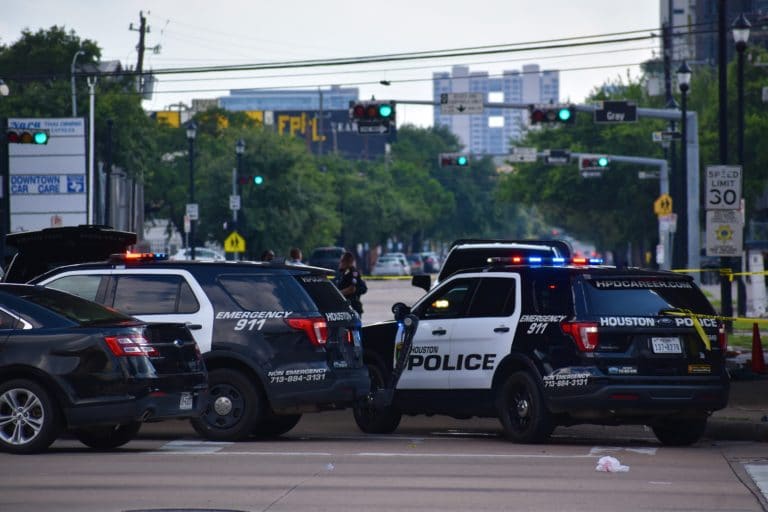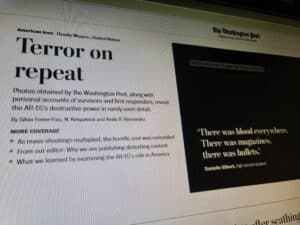Depending on what count you look at, Monday’s attack on a Louisville bank was either the 146th, 15th, or 4th mass shooting of 2023.
The huge variation in counts makes it very difficult to properly understand the scale of the issue. It creates confusion among the public and policymakers alike. But no official government definition of “mass shooting” exists, and the problem will likely persist for the foreseeable future, which is a good reason to understand the most prominent counts out there.
So, what are the different counts, and why do they vary so much?
The Violence Project (TVP) definition, derived from a 2015 Congressional Research Service report, includes events where four or more people are killed in public shootings, except those attributable to underlying criminal activity, such as robberies or gang fights. The USA Today/Associated Press/Northeastern University database counts any and all events where four or more people are killed (including with weapons other than firearms). The Gun Violence Archive (GVA) includes all events where four or more people are injured in a shooting.
There are more counts out there from The Washington Post, Mother Jones, and a few others that vary slightly. But the three above cover the primary methodologies that exist.
One clear commonality between those three definitions is the key marker for victims being four or more. That’s derived from the FBI’s generally accepted definition of “mass murder,” which sets the threshold of victims over a short period of time at four. The main difference between the lower counts from TVP and USA Today and the higher count from GVA is in whether just deaths should be included or also injuries. Is a “mass shooting” a mass murder committed with a gun or a mass attack with a gun?
Each approach has different strengths and weaknesses.
The main problem with the broader count is that it includes many shootings that many Americans wouldn’t think of as “mass shootings.” In fact, it’s likely the vast majority of the 146 attacks don’t resemble somewhat random attacks on groups of people in public by a lone gunman. Instead, many are crime-related incidents or gang shootings–critical issues to find solutions for, but not the same problem as something like Uvalde or Las Vegas.
The USA Today count suffers from a similar but less pronounced problem. It captures a phenomenon that’s sadly even more common in American society than randomized public killings: domestic murders. Most of the 15 events it chronicles are incidents where someone murders their entire family in their own home–another type of killing that’s important to find strategies to prevent, but still different from the attacks in Parkland or El Paso.
The TVP count, which is the most restrictive, does a better job of capturing the events most Americans would understand as “mass shootings.” It is a list of almost all the “mass shootings” that have received in-depth national media coverage. In addition to the Louisville bank attack, TVP’s count includes the two mass shootings experienced by Asian-American communities in California earlier this year and the murder of six people at a Christian school in Nashville late last month.
Of course, the restrictive nature of the TVP count has its own drawbacks. It only provides insight into mass shootings where the perpetrator actually accomplished their goal of killing many people. The FBI’s active shooter report suggests a number of people each year who attempt to carry out such an attack but are unsuccessful at killing many people for various reasons. Sometimes this means that shootings that look a lot like what people would think of as “mass shootings” and garner significant national attention, such as February’s deadly shooting at Michigan State University, don’t make the list because it doesn’t pass the grim milestone of four killed.
Still, The Violence Project is the best measure of how often someone successfully carries out one of these horrendous attacks. It also has data on every shooting that meets its criteria going back to 1966. That gives it a leg up on the other databases since USA Today‘s data begins in 2006, and GVA’s starts in 2013.
That helps provide a broader view of trends in mass shootings. The GVA number gets brought up a lot in media coverage because it’s large and has gotten much larger in recent years. But, since it tracks a much broader class of shootings and is likely correlating closer to overall gun violence, the fact that it only captures the last ten years likely doesn’t tell us much about long-term trends in mass shootings. It may well tell us that shootings and murders have increased recently, which seems to be the case.
But America has experienced a remarkable lull in violent crime and murder over the past two decades. The 1980s and 90s had far higher rates of violent crime and murder than the 2000s or 2010s. The early 2020s may be pushing us backward in this regard, but perhaps not as much as the GVA count of mass shootings would imply.
That doesn’t mean mass shootings aren’t getting worse. TVP’s count shows there was only one mass shooting per year from the mid-1960s through the mid-1980s. Outside of 2020, the last five years have seen no fewer than 7 per year. And they’re getting deadlier too.
However, while the frequency is up overall, the 1990s also saw a noticeably higher frequency of mass shootings than the decades immediately before and after it. 1999 was the worst year for mass shootings, with seven incidents, until 2018 saw eight.
So, TVP’s data shows mass shootings have been getting worse in recent years. But the shift hasn’t been as dramatic as what USA Today or, especially, GVA count shows.
There is widespread agreement that mass shootings are a significant societal problem that needs to be solved but bitter debate over the best policies to do so. The considerable variation in how we even count such attacks is part of the problem. But, since consensus on the best methodology is unlikely in the near term, it’s essential that everyone at least understands the critical differences between them as they exist today.







One Response
Thank you, The Reload. I still vote for GVA’s “injuries” as becoming an accepted standard, Thankfully over the decades, trauma care has vastly improved from “stop the bleed” to advanced lifesaving in the ER.
But The Violence Project also seems the gold standard. Maybe because “GVA” has “gun” in it, and is biased and skewed to Aunty Anti’s gun controls agenda, we should raise them up instead. Then insist that injuries count too; I’d finished WaPo’s account about how Sutherland Springs survivors still and will suffer from lead poisoning, painful rehabilitation, grief and nightmares.
More importantly for policies, violence can’t be umbrellaed under just “gun violence”, and should be broken out into categories, like:
“mass public gun-related violence”, “mass public knife-related violence”, “mass public vehicle-related violence” (e.g. Waukesha Christmas Parade), “mass gang gun-related violence”, “mass domestic blunt object-related violence” (e.g. Charleston County 2018 Manigault Murders), “mass robbery gun-related violence” (e.g. May 2000 Wendys Robbery-Murders), etc.
So, “mass” covers the four or more (excl. perpetrator), 2nd term covers strangers in “public”, the criminal relations with “gang” or “robbery”, 3rd term “gun-“, “knife-“, “blunt object-” and so on with the all important “related” for the primary weapon used to conduct the most violence (thank you Kostas Moros on Twitter for emphasizing the “related” modifier, as we still insistently argue that objects, like firearms, have no agency)
Thank you if you got this far, I hope this helps anyone reading.